
 Dedicated volunteers drive the program
Dedicated volunteers drive the program
Florida Horseshoe Crab Watch (FHCW) is a citizen science program that is quickly becoming established along Florida’s coast. The fall 2018 sampling season (Sept-Oct 2018) was the 6th round of horseshoe crab nesting surveys and tagging by citizen scientists on Cedar Key beaches. The fall 2018 season was the 4th round for Hagen’s Cove and Shired Island beaches and the 3rd round for Bald Point State Park. The rapid growth of the program is exciting! New programs have started all over the state in 2018 as more and more volunteer coordinators join the team.
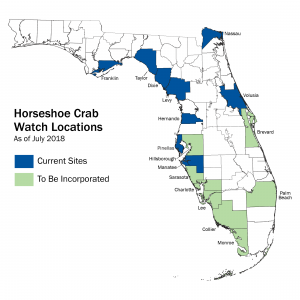
 The number of volunteers is growing, too, up from 20 active volunteers in Fall 2016, 106 volunteers in 2017, to over 133 active citizen volunteers in 2018. This wonderful, dedicated volunteer corps donated over 942 hours and traveled a total of 21,253 miles to complete the Nature Coast area surveys in 2018! In 2018 alone, our citizen scientists went above and beyond their basic data collection duties. Our volunteers educated at least 397 people in the Nature Coast about horseshoe crabs. Most of these educational opportunities arise when volunteers are walking the beach on their surveys and are approached by curious beachgoers. A few volunteers even wrote articles for their local newspapers, including Master Gardener coordinator Barbara Edmonds and Bald Point site coordinator Rosalyn Kilcollins!
The number of volunteers is growing, too, up from 20 active volunteers in Fall 2016, 106 volunteers in 2017, to over 133 active citizen volunteers in 2018. This wonderful, dedicated volunteer corps donated over 942 hours and traveled a total of 21,253 miles to complete the Nature Coast area surveys in 2018! In 2018 alone, our citizen scientists went above and beyond their basic data collection duties. Our volunteers educated at least 397 people in the Nature Coast about horseshoe crabs. Most of these educational opportunities arise when volunteers are walking the beach on their surveys and are approached by curious beachgoers. A few volunteers even wrote articles for their local newspapers, including Master Gardener coordinator Barbara Edmonds and Bald Point site coordinator Rosalyn Kilcollins!
Citizen scientists collect high quality data
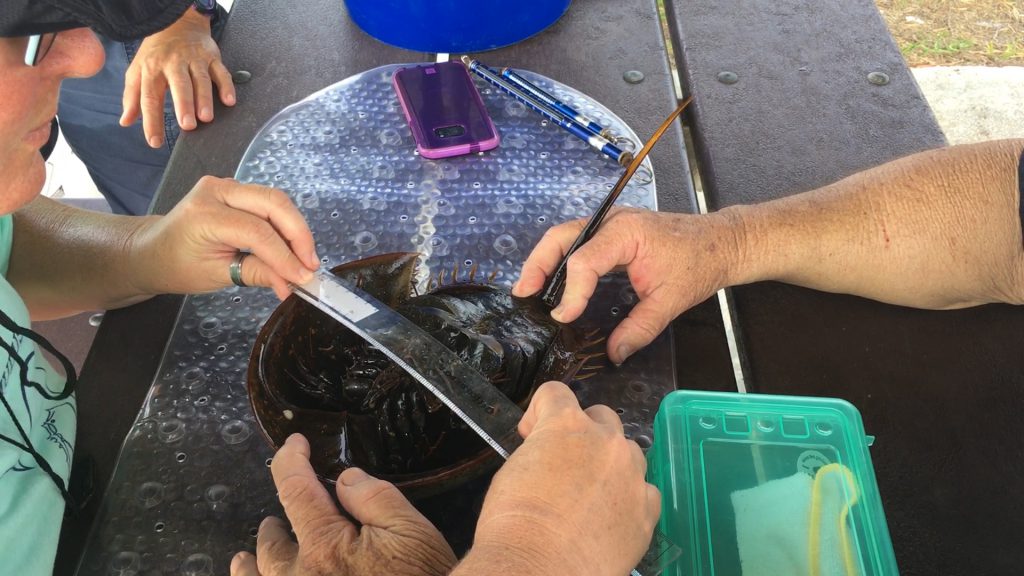 In 2018, volunteers completed a total of 230 surveys at 16 different sites across 5 counties statewide. Simultaneous sampling across such a large geographic area would be impossible without the help of citizen scientists. The Florida Fish and Wildlife Conservation Commission is dedicated to collecting data on horseshoe crab nesting, but does not have anywhere near enough staff to achieve the high level of data collection the volunteers are able to complete. A major accomplishment of FHCW in 2017-2018 was the incorporation of data collected by volunteers into federal stock assessment models. These models are used to make decisions about the number of horseshoe crabs that can be safely removed by the fishery each year. This is a major nod to the quality data collected by our hardworking volunteers!
In 2018, volunteers completed a total of 230 surveys at 16 different sites across 5 counties statewide. Simultaneous sampling across such a large geographic area would be impossible without the help of citizen scientists. The Florida Fish and Wildlife Conservation Commission is dedicated to collecting data on horseshoe crab nesting, but does not have anywhere near enough staff to achieve the high level of data collection the volunteers are able to complete. A major accomplishment of FHCW in 2017-2018 was the incorporation of data collected by volunteers into federal stock assessment models. These models are used to make decisions about the number of horseshoe crabs that can be safely removed by the fishery each year. This is a major nod to the quality data collected by our hardworking volunteers!
How can the public help?
If you see a tagged horseshoe crab, alive or dead, you can really help our data collection efforts by reporting the tagged animal. To report a tag, follow the instructions below. You can download the picture to your phone so you will always have the information.
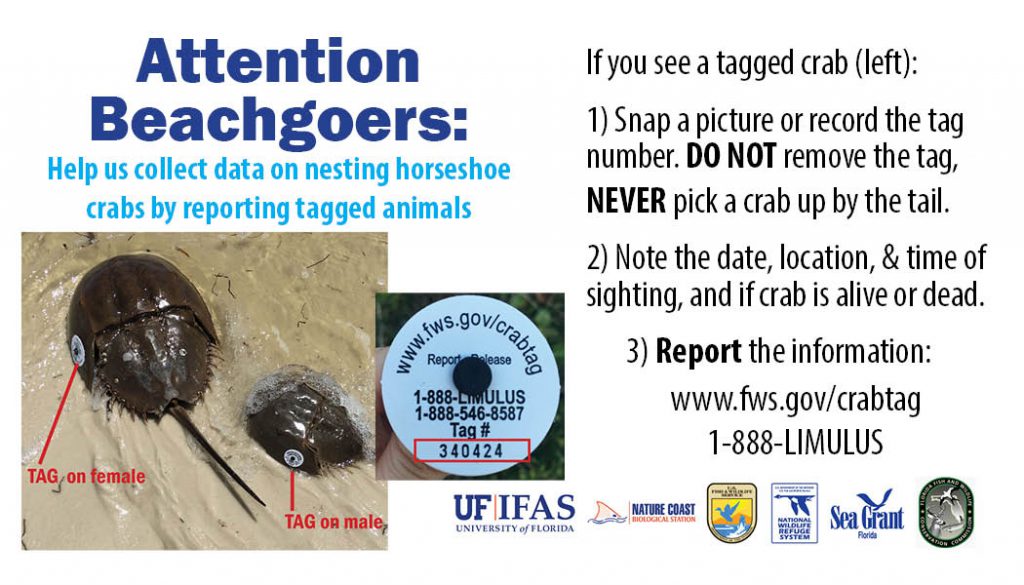
2018 Florida Horseshoe Crab Watch Data Summary
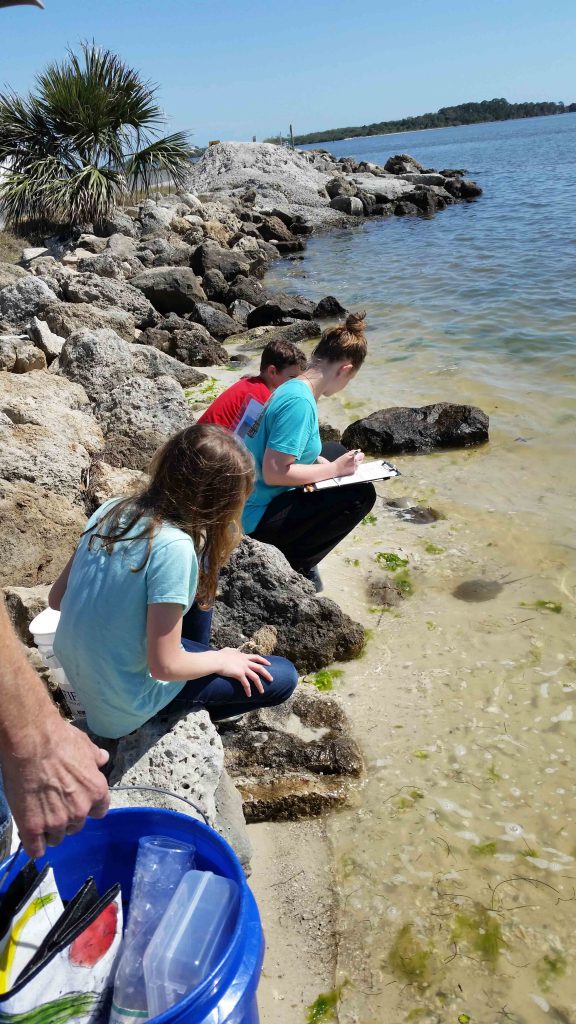 Surveys: In the spring, volunteers observed a total of 1,973 horseshoe crabs on 13 nesting beaches. As in previous sampling seasons, there were more males (1,244) observed than females (729) on the nesting beaches. The highest number observed in any one survey this past spring was 349 crabs at Bald Point State Park on 4/19/2018. Seahorse Key the 2nd highest with 133 on 4/4/2018. In the fall, volunteers observed a total of 2,506 horseshoe crabs on 7 Nature Coast nesting beaches. Again, there were more males (1,663) observed than females (843) on the nesting beaches. The highest number observed in a fall survey was 847 crabs at Hagen’s Cove in Steinhatchee on 10/7/2018. Airport Rd in Cedar Key had the 2nd highest total number observed on 10/8/2017 – 264 crabs).
Surveys: In the spring, volunteers observed a total of 1,973 horseshoe crabs on 13 nesting beaches. As in previous sampling seasons, there were more males (1,244) observed than females (729) on the nesting beaches. The highest number observed in any one survey this past spring was 349 crabs at Bald Point State Park on 4/19/2018. Seahorse Key the 2nd highest with 133 on 4/4/2018. In the fall, volunteers observed a total of 2,506 horseshoe crabs on 7 Nature Coast nesting beaches. Again, there were more males (1,663) observed than females (843) on the nesting beaches. The highest number observed in a fall survey was 847 crabs at Hagen’s Cove in Steinhatchee on 10/7/2018. Airport Rd in Cedar Key had the 2nd highest total number observed on 10/8/2017 – 264 crabs).
Tagging and resighting: In the spring, volunteers collected, tagged, and released 227 crabs and 17 tagged individuals were seen again (resighted). In the fall, volunteers collected, tagged, and released 514 crabs. Out of these, 50 tagged individuals were seen again (resighted). The overall tag resighting rate for 2018 was 9.1% (2017 was 7.2%, 2016 was 11%). We are getting excellent data from the tagging effort! Want to see if a crab you tagged was resighted? Check out the link below for that info and more about resighted crabs!
Click here to view the tag resighting info for 2017 and 2018
 Tag resighting data is the most important type of collected by the citizen scientists. Tag resighting data is used to estimate population sizes but also can tell biologist important information about horseshoe crab nesting behavior. Tagging data from 2016-2018 suggests that horseshoe crabs move a good deal more among nesting beaches than previously thought. In 2018, 44 crabs were resighted on a different beach than the one where they were tagged and 55 were resighted on the same beach. More data is needed to continue assessing this aspect of horseshoe crab behavior and help determine if the behavior differs between males and females.
Tag resighting data is the most important type of collected by the citizen scientists. Tag resighting data is used to estimate population sizes but also can tell biologist important information about horseshoe crab nesting behavior. Tagging data from 2016-2018 suggests that horseshoe crabs move a good deal more among nesting beaches than previously thought. In 2018, 44 crabs were resighted on a different beach than the one where they were tagged and 55 were resighted on the same beach. More data is needed to continue assessing this aspect of horseshoe crab behavior and help determine if the behavior differs between males and females.
Stay tuned for more!
Florida Horseshoe Crab Watch will continue in Spring 2019, and may be coming to a beach near you! Visit https://ncbs.ifas.ufl.edu/extension/florida-horseshoe-crab-watch/ or email savanna.barry @ ufl.edu for more information about how to get involved in Florida Horseshoe Crab Watch.
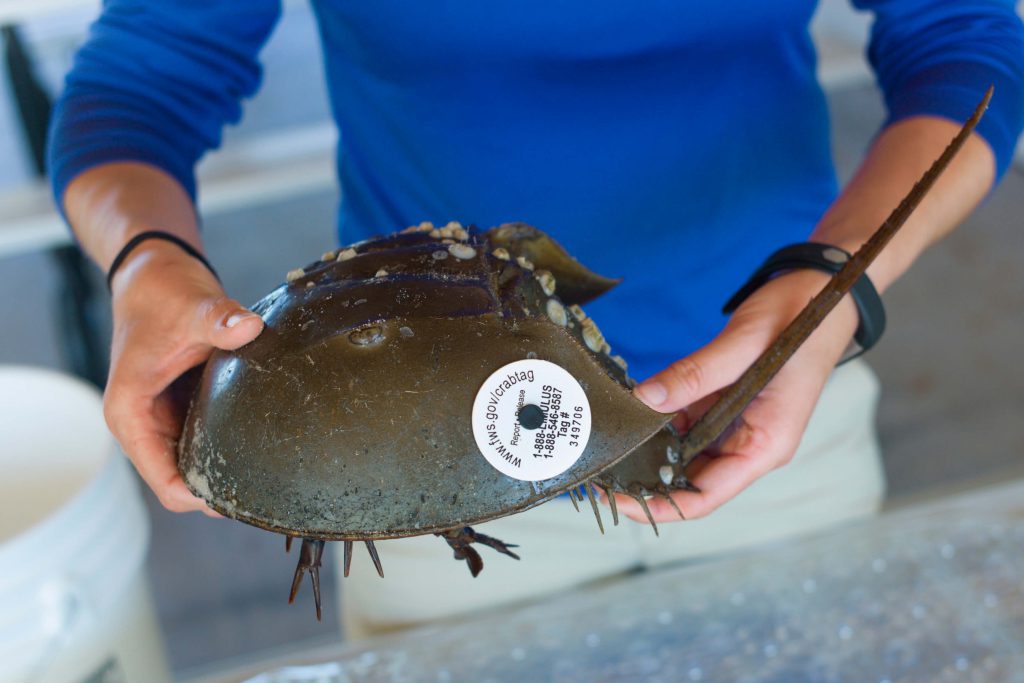
 0
0
 Dedicated volunteers drive the program
Dedicated volunteers drive the program